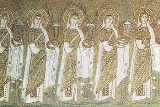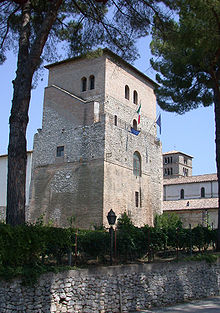
Victoria, Anatolia, and Audax
Encyclopedia
Saints Victoria, Anatolia, and Audax are venerated as martyr
s and saints by the Catholic Church. Victoria and Anatolia are mentioned (without Audax) in the Roman Martyrology
under the date of 10 July. Anatolia was first mentioned in the De Laude Sanctorum composed in 396 by Victrice (Victricius), bishop of Rouen
(330-409). Anatolia and Victoria are mentioned together in the Martyrologium Hieronymianum
under 10 July: VI idus iulii in Savinis Anatholiae Victoriae; Victoria is also mentioned alone under 19 December: In Savinis civitate Tribulana Victoriae. The two saints appear in the mosaics of Basilica of Sant'Apollinare Nuovo
, at Ravenna
, between Saints Paulina
and Christina. A Passio SS. Anatoliae et Audacis et S. Victoriae of the 6th or seventh century, which added the name of Audax, was mentioned by Aldhelm (died 709) and Bede
(died 735), who list the saints in their martyrologies. Caesar Baronius
lists Anatolia and Audax under 9 July and Victoria under 23 December.
to two noble, non-Christian Roman
men. They resisted matrimony and their prospective grooms denounced them as Christians. They received permission to imprison the women on their estates and convince them to renounce their faith.
Anatolia's suitor, Titus Aurelius, gave up, and handed her back to the authorities. Victoria’s suitor, Eugenius, was more persistent, but also ended up returning her to the authorities.
). An elaboration on her legend states that her murderer was immediately struck with leprosy
, and died six days later.
Anatolia was killed, also in 250 AD, at "Thora" (city that was in places where it is now Sant'Anatolia di Borgorose). Her legend states that she was at first locked up with a poisonous snake
. The snake refused to bite her, and a soldier named Audax was sent into her cell to kill her. The snake attacked him instead, but Anatolia saved him from the snake. Impressed by her example, he converted to Christianity
and was martyred by the sword with her.
 Due to the translation of their relics
Due to the translation of their relics
, their cult spread across Italy. The body of Saint Victoria was transferred in 827 by Abbot Peter of Farfa to Mount Matenano from the Piceno because of the Moorish invasions. The town of Santa Vittoria in Matenano
is named after her. Ratfredus, subsequent Abbot of Farfa, brought the body to Farfa on 20 June 931.
The bodies of Anatolia and Audax were transferred by Abbot Leo to Subiaco
around 950. At an unknown date, a scapula of Anatolia was translated to the present-day Sant'Anatolia di Borgorose and an arm of the saint was translated to the present-day Esanatoglia
The bodies of Anatolia and Audax still rest at Subiaco in the basilica
of Santa Scholastica, under the altar
of the sacrament
. her feast day was actually JULY 9th.
} Santa Anatolia
} Santa Vittoria
Martyr
A martyr is somebody who suffers persecution and death for refusing to renounce, or accept, a belief or cause, usually religious.-Meaning:...
s and saints by the Catholic Church. Victoria and Anatolia are mentioned (without Audax) in the Roman Martyrology
Roman Martyrology
The Roman Martyrology is the official martyrology of the Roman Rite of the Roman Catholic Church. It provides an extensive but not exhaustive list of the saints recognized by the Church.-History:...
under the date of 10 July. Anatolia was first mentioned in the De Laude Sanctorum composed in 396 by Victrice (Victricius), bishop of Rouen
Victricius
Saint Victricius was a bishop of Rouen , missionary, and author. His feast day is August 7. Victricius was the son of a Roman legionnaire, and was in the army himself. However, when he became a Christian, he refused to remain in the army. He was flogged and sentenced for execution, but...
(330-409). Anatolia and Victoria are mentioned together in the Martyrologium Hieronymianum
Martyrologium Hieronymianum
The Martyrologium Hieronymianum was a medieval list of martyrs, one of the most used and influential of the Middle Ages...
under 10 July: VI idus iulii in Savinis Anatholiae Victoriae; Victoria is also mentioned alone under 19 December: In Savinis civitate Tribulana Victoriae. The two saints appear in the mosaics of Basilica of Sant'Apollinare Nuovo
Basilica of Sant'Apollinare Nuovo
The Basilica of Sant' Apollinare Nuovo is a basilica church in Ravenna, Emilia-Romagna . It was erected by the Ostrogoth King Theodoric as his palace chapel, during the first quarter of the 6th century...
, at Ravenna
Ravenna
Ravenna is the capital city of the Province of Ravenna in the Emilia-Romagna region of Italy and the second largest comune in Italy by land area, although, at , it is little more than half the size of the largest comune, Rome...
, between Saints Paulina
Saint Paulina
Saint Paulina, born Amabile Lucia Visintainer , was a Brazilian nun of Italian origin which became the first Brazilian citizen to be canonized when proclaimed a saint on May 19, 2002, by Pope John Paul II...
and Christina. A Passio SS. Anatoliae et Audacis et S. Victoriae of the 6th or seventh century, which added the name of Audax, was mentioned by Aldhelm (died 709) and Bede
Bede
Bede , also referred to as Saint Bede or the Venerable Bede , was a monk at the Northumbrian monastery of Saint Peter at Monkwearmouth, today part of Sunderland, England, and of its companion monastery, Saint Paul's, in modern Jarrow , both in the Kingdom of Northumbria...
(died 735), who list the saints in their martyrologies. Caesar Baronius
Caesar Baronius
Cesare Baronio was an Italian Cardinal and ecclesiastical historian...
lists Anatolia and Audax under 9 July and Victoria under 23 December.
Legend
Their legend, a lengthy account of which is found on the second of the two Italian websites listed below under "External links", recounts that, in the time of the Emperor Decius, Anatolia and Victoria were sisters whose marriage was arrangedArranged marriage
An arranged marriage is a practice in which someone other than the couple getting married makes the selection of the persons to be wed, meanwhile curtailing or avoiding the process of courtship. Such marriages had deep roots in royal and aristocratic families around the world...
to two noble, non-Christian Roman
Roman Empire
The Roman Empire was the post-Republican period of the ancient Roman civilization, characterised by an autocratic form of government and large territorial holdings in Europe and around the Mediterranean....
men. They resisted matrimony and their prospective grooms denounced them as Christians. They received permission to imprison the women on their estates and convince them to renounce their faith.
Anatolia's suitor, Titus Aurelius, gave up, and handed her back to the authorities. Victoria’s suitor, Eugenius, was more persistent, but also ended up returning her to the authorities.
Deaths
Victoria’s legend states that she was stabbed through the heart in 250 AD at Trebula Mutuesca (today Monteleone SabinoMonteleone Sabino
Monteleone Sabino is a comune in the Province of Rieti in the Italian region Latium, located about 45 km northeast of Rome and about 20 km south of Rieti....
). An elaboration on her legend states that her murderer was immediately struck with leprosy
Leprosy
Leprosy or Hansen's disease is a chronic disease caused by the bacteria Mycobacterium leprae and Mycobacterium lepromatosis. Named after physician Gerhard Armauer Hansen, leprosy is primarily a granulomatous disease of the peripheral nerves and mucosa of the upper respiratory tract; skin lesions...
, and died six days later.
Anatolia was killed, also in 250 AD, at "Thora" (city that was in places where it is now Sant'Anatolia di Borgorose). Her legend states that she was at first locked up with a poisonous snake
Snake
Snakes are elongate, legless, carnivorous reptiles of the suborder Serpentes that can be distinguished from legless lizards by their lack of eyelids and external ears. Like all squamates, snakes are ectothermic, amniote vertebrates covered in overlapping scales...
. The snake refused to bite her, and a soldier named Audax was sent into her cell to kill her. The snake attacked him instead, but Anatolia saved him from the snake. Impressed by her example, he converted to Christianity
Christianity
Christianity is a monotheistic religion based on the life and teachings of Jesus as presented in canonical gospels and other New Testament writings...
and was martyred by the sword with her.
Spread of cult

Translation (relics)
In Christianity, the translation of relics is the removal of holy objects from one locality to another ; usually only the movement of the remains of the saint's body would be treated so formally, with secondary relics such as items of clothing treated with less ceremony...
, their cult spread across Italy. The body of Saint Victoria was transferred in 827 by Abbot Peter of Farfa to Mount Matenano from the Piceno because of the Moorish invasions. The town of Santa Vittoria in Matenano
Santa Vittoria in Matenano
Santa Vittoria in Matenano is a comune in the Province of Fermo in the Italian region Marche, located about 70 km south of Ancona and about 20 km northwest of Ascoli Piceno....
is named after her. Ratfredus, subsequent Abbot of Farfa, brought the body to Farfa on 20 June 931.
The bodies of Anatolia and Audax were transferred by Abbot Leo to Subiaco
Subiaco, Italy
Subiaco is a town and comune in the Province of Rome, in Lazio, Italy, from Tivoli alongside the river Aniene. It is mainly renowned as a tourist and religious resort for its sacred grotto , in the St. Benedict's Abbey, and the other Abbey of St. Scholastica...
around 950. At an unknown date, a scapula of Anatolia was translated to the present-day Sant'Anatolia di Borgorose and an arm of the saint was translated to the present-day Esanatoglia
Esanatoglia
-History:According to the legend, Esus, the Celtic God of war, would be the origin of the name of the Esino river, on whose shores a town, Aesa, is presumed to have been founded in Roman times....
The bodies of Anatolia and Audax still rest at Subiaco in the basilica
Basilica
The Latin word basilica , was originally used to describe a Roman public building, usually located in the forum of a Roman town. Public basilicas began to appear in Hellenistic cities in the 2nd century BC.The term was also applied to buildings used for religious purposes...
of Santa Scholastica, under the altar
Altar
An altar is any structure upon which offerings such as sacrifices are made for religious purposes. Altars are usually found at shrines, and they can be located in temples, churches and other places of worship...
of the sacrament
Eucharist
The Eucharist , also called Holy Communion, the Sacrament of the Altar, the Blessed Sacrament, the Lord's Supper, and other names, is a Christian sacrament or ordinance...
. her feast day was actually JULY 9th.
External links
- At Catholic Forum (incorrect on date and rank of feast)
- At Santi, Beati e Testimoni
} Santa Anatolia
} Santa Vittoria
- At Santa Anatolia (a town in the province of RietiRietiRieti is a city and comune in Lazio, central Italy, with a population of c. 47,700. It is the capital of province of Rieti.The town centre rests on a small hilltop, commanding a wide plain at the southern edge of an ancient lake. The area is now the fertile basin of the Velino River...
) Santa Anatolia (for the legend of Anatolia and Victoria, click on "S. Anatolia" in the index on the left)

